Lincoln Town Car
| Lincoln Town Car | |
|---|---|
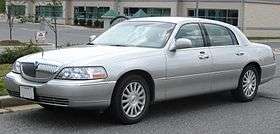 | |
| Overview | |
| Manufacturer | Lincoln (Ford) |
| Model years | 1981–2011 |
| Body and chassis | |
| Class |
Full-size luxury car Limousine Armored car |
| Layout | FR layout |
| Platform | Ford Panther platform |
| Related |
Mercury Grand Marquis Ford Crown Victoria |
| Chronology | |
| Predecessor | Lincoln Continental (1980) |
| Successor |
Lincoln MKS (livery/civilian) Lincoln MKT (limousine/hearse) |
The Lincoln Town Car is a model line of full-size luxury sedans that was marketed by the Lincoln division of the American automaker Ford Motor Company from 1981 to 2011. Deriving its name from a style of limousine, "Town Car" translated in French is the term "Sedan de Ville" (the Cadillac rival to the Lincoln Continental from the 1950s to the 1990s). The Town Car nameplate first appeared as a sub-model of the Continental in 1959, later becoming a trim line during the 1970s. In 1981, the Lincoln Town Car became a distinct product, taking the place of the Continental in the Lincoln model line.
Produced in three separate generations, the Lincoln Town Car was based solely on the rear-wheel drive Ford Panther platform, sharing its chassis and mechanical components with the Mercury Grand Marquis and the Ford (LTD) Crown Victoria. With the exception of two-door sedans sold in 1981, the Town Car was produced in a single four-door body style. Following the 1996 discontinuation of the Cadillac Fleetwood Brougham, the Town Car became the longest (though not the heaviest) mass-produced sedan assembled in the Western Hemisphere for the rest of its production.[1] Within Ford Motor Company, the Lincoln Town Car marked the introduction of several significant features and technologies, including fuel-injected engines, 4-speed overdrive automatic transmissions, keyless entry, and overhead-cam V8 engines.
Marketed primarily in the United States and Canada, the Town Car saw exports worldwide. From 1981 to 2007, the Lincoln Town Car was assembled at Wixom Assembly, at Wixom, Michigan, alongside the Lincoln Continental, Mark Series, and Lincoln LS. Following the closure of Wixom Assembly, production of the Town Car was moved to St. Thomas Assembly in Southwold, Ontario, Canada, alongside the Ford Crown Victoria and Mercury Grand Marquis. In 2011, production of all three Panther-platform vehicles ended as the St. Thomas facility ended production in September 2011.
Background
Etymology
.jpg)
In the 1920s, a town car was a type of limousine that gained popularity among automobile buyers. The design featured an open chauffeur's compartment with either a fixed or convertible roof for the rear passengers. In 1922, Edsel Ford purchased a custom-built Lincoln L-Series town car as a personal vehicle for his father, Henry Ford.[2]
Continental Town Car
In the 1950s, Cadillac and Lincoln would introduce the de Ville/Town Car nameplates; however, the design path taken by each company would vary.
While Cadillac styled the de Ville series as a hardtop coupe and sedan, in 1959, the Town Car was introduced as a limousine variant of the Continental Mark IV four-door sedan. In place of the reverse-slant roofline of the standard Mark IV the Town Car was given a formal profile to its roofline with a padded vinyl top (one of the first cars to do so). Due to its formal nature, all Continental Town Cars were sold in black. In addition to the formal styling, the roofline was designed for the ability to add rear legroom without further extending the wheelbase; the rear seat was shifted several inches rearward.
As only 214 Continental Town Cars were sold from 1959 to 1960, the nameplate went dormant for a decade, becoming an option for 1969; in place of a sub-model, the Town Car returned as a trim package. As part of the 1970 redesign of the Lincoln Continental, the Lincoln Continental Town Car trim made its return ("Continental's Town Car Interior option", to quote from the 1970 deluxe catalog), remaining through 1980. As an option package, the Continental Town Car featured additional standard equipment and an extra plush interior (Media velour cloth).
On nearly all 1970-1979 Lincoln Continental Town Cars, the vinyl roof covered half the roof, aft of the B-pillar (though the fixed roof over the driver remained). To suggest a partition, a raised molding sweeping over the roof was added, featuring coach lamps. As an option, some models of the Town Car featured a full-length padded roof. From 1973 to 1981, two-door Lincoln Continentals were available with a similar option called the Lincoln Continental Town Coupe'.
First generation (1981–1989)
| First generation | |
|---|---|
 1989 Lincoln Town Car | |
| Overview | |
| Also called | Lincoln Continental (1980) |
| Production | 1980–1989 |
| Model years | 1981–1989 |
| Assembly | United States: Wixom, Michigan (Wixom Assembly Plant) |
| Body and chassis | |
| Body style |
4-door sedan 2-door sedan |
| Related |
Lincoln Continental Mark VI Mercury Grand Marquis Ford LTD Crown Victoria |
| Powertrain | |
| Engine | 4.9 L (302 cu in) 5.0L Windsor V8 |
| Transmission | 4-speed AOD automatic |
| Dimensions | |
| Wheelbase | 117.3 in (2,979 mm) |
| Length | 219.2 in (5,568 mm)[3] |
| Width | 78.1 in (1,984 mm) |
| Height | 55.9 in (1,420 mm) |
| Curb weight |
2-door: 3,993 pounds (1,811 kg)[4] 4-door: 4,006–4,120 pounds (1,817–1,869 kg)[5][6] |
After lagging behind rival Cadillac for three model years, Lincoln became the final American luxury brand to market downsized full-size cars for the 1980 model year with the introduction of the redesigned Lincoln Continental and all-new Continental Mark VI. As before, Lincoln offered the Continental two-door/four-door in its standard trim with the Continental Town Car/Town Coupe as the top-line trim. Although technically not badged a Lincoln, the Continental Mark VI two-door and four-door shared much of the body of the standard Lincoln Continental (to reduce development costs), with the Town Car essentially slotted between the Continental and the Mark VI.
For the 1981 model year, Lincoln made a number of revisions to its model line (as it had essentially sold three versions of the same car for 1980). To diversify its model lineup, the standard Continental was put on a year-long hiatus and the nameplate moved to a mid-size sedan introduced as an early 1982 model. The flagship Mark VI remained to live out its model cycle as its replacement Mark VII was designed for a completely different market segment. As the remaining full-size Lincoln, the Continental Town Car was renamed the Lincoln Town Car for 1981.
Chassis
The 1980-1989 Lincoln Continental/Town Car utilized the Panther platform shared with Ford and Mercury. Delayed to the 1980 model year due to engineering issues, the Panther platform would give the Continental/Town Car radically different exterior dimensions from its predecessor. Although the Lincoln version of the Panther platform was stretched three inches in wheelbase over its Ford/Mercury/Mark VI coupe counterparts, the 1980 Lincoln would have the shortest wheelbase ever for a full-size Lincoln at the time (10 inches shorter than its 1979 predecessor; shorter than a Mercedes-Benz 380SEL). The 1980 Continental/Town Car was the shortest Lincoln since 1955, asides from the far-smaller Versailles (14 inches shorter than 1979). In the interest of fuel economy and handling, the Panther chassis reduced weight by up to 1400 lbs over the heaviest versions of the 1970-1979 full-size Lincolns; the lightest full-size Lincoln in 40 years, the 1980 Continental/Town Car came within less than 200 pounds of the curb weight of the Versailles.
The new Panther platform allowed for advances in suspension geometry and many upgrades were made to the power steering. With the handling improvements and reduced overall size, the Town Car featured an improved ride coupled with better overall road manners. Compared to its GM counterparts and Lincoln predecessors, the new-generation Lincoln offered more agile maneuvering, as well as a reduced turn diameter by over 8 feet (compared to the 1979 Lincoln Continental). In an effort to improve handling, Lincoln added gas-pressurized shocks for the Town Car in 1984.
In order for the division to attain fuel economy targets mandated by the federal governments through CAFE, Ford abandoned the use of its 400 and 460 big-block V8s in its full-size cars. For 1980, Ford introduced its first fuel-injected V8 engine in North America: the familiar 302 Windsor V8 (marketed by its metric displacement, rounded up to 5.0L). Ford paired the 130 hp engine with the 4-speed AOD automatic overdrive transmission; exclusive to Lincoln for 1980, Ford expanded the AOD to all of its full-size cars for 1981. Although it would remain in production with Ford police cars, Lincoln removed the 351 V8 as an option in 1981. In Canadian-market vehicles, central fuel injection was not added to the 5.0L V8 until 1985. In 1986, the fuel injection system on the 5.0L V8 of all Panther-platform vehicles (Ford and Lincoln-Mercury) was changed from CFI (throttle-body) to sequential multi-port fuel injection. These engines are easily distinguished by their cast aluminum upper intake manifolds with horizontal throttle body (vertical throttle plate); this replaced the traditional throttle body with a carburetor-style top-mounted air cleaner previously used.
All Town Cars from 1980 to 1989 featured an optional trailer towing package which included: dual exhausts, a 3.55:1 limited slip differential (code 'K') and an improved cooling package for the engine as well as transmission.
| Engine | Displacement | Fuel System | Years produced | Horsepower rating | Torque output | Notes | Transmission |
|---|---|---|---|---|---|---|---|
| Ford 5.0 Windsor V8 | 4.9 liters (302 cu in) | CFI (USA; Canada 1985)
2bbl carburetor (Canada 1981-1984) |
1981 | 130 hp (97 kW) at 3400 rpm | 230 lb·ft (310 N·m) at 2,200 rpm | Ford 4-speed AOD automatic | |
| 1982 | 134 hp (100 kW) at 3400 rpm | 245 lb·ft (332 N·m) at 2,200 rpm | |||||
| 1983 | 140 hp (104 kW) at 3200 rpm | 250 lb·ft (340 N·m). at 2,000 rpm | |||||
| 1984-1985 | 140 hp (104 kW) at 3200 rpm | 250 lb·ft (340 N·m) at 1,600 rpm | |||||
| 155 hp (116 kW) at 3600 rpm | 265 lb·ft (359 N·m). at 2,000 rpm | dual exhaust option | |||||
| SEFI | 1986-1989 | 150 hp (110 kW) | 270 lb·ft (370 N·m) at 2,000 rpm | ||||
| 160 hp (120 kW) | 280 lb·ft (380 N·m) at 2,200 rpm | dual exhaust option |
Body
Exterior
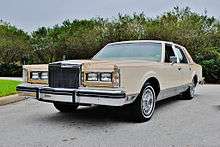
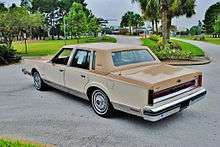

As the sales of full-size Lincolns had held steady during the late 1970s, Lincoln stylists chose to include of styling themes of the previous Continental and Mark V on the Continental/Town Car. These evolutionary features include flat-sided, sharp-edged fenders, a radiator-style grille, full-width taillamps, wraparound marker lamps (though exposed rectangular headlamps replaced hideaway headlamps on Lincoln models) and retractable vent windows (becoming standard, one of the last cars to include them as a feature). As a first for a Lincoln Continental/Town Car, the door glass was fully framed; in an unusual design, the window frames were painted matte black.
In the shift from rebadging the Continental to the Lincoln Town Car for 1981, Lincoln replaced the "Continental" badging above the headlights with "Town Car", which was removed in 1984.
Though mechanically similar to the Ford LTD and Mercury Marquis (the Ford LTD Crown Victoria and Mercury Grand Marquis after 1983), the Lincoln Town Car shared no visible body panels with any other Panther-chassis Fords. In contrast to its Ford, Mercury, and Mark VI counterparts, the rooflines of 1980 Town Cars feature a vertical quarter window in the C-pillar. A padded roof was standard equipment on all Town Cars, depending on trim level. On standard-trim Town Cars, a leather-grained vinyl full-roof covering with center pillar coach lamps was fitted, while a padded vinyl coach roof (covering only the rear half of the roof) with a frenched (smaller) rear window opening was included on Signature Series and Cartier models (and optional on base Town Car). A cloth (Canvas) roof—re-creating the look of a convertible—was optional on all except Cartier.
After only 4,935 two-door Town Cars were sold in 1981, the bodystyle was discontinued for 1982, making it one of the rarest versions of the Panther-chassis Fords.
For 1985, the Town Car saw a mid-cycle facelift, to slightly improve its aerodynamics, while visually shortening the car. The front and rear bumpers were modified to better integrate them into the fenders. The rear fascia was redesigned with larger taillights, matching the slope of the rear window. In 1986, a center brake light was added to meet federal government regulations. For 1988, the Town Car received a minor update coinciding with the introduction of the all-new Continental. The front fascia returned the traditional radiator-style grille, while the rear fascia was redesigned with a brushed-metal panel between the taillights; the reverse lamps are moved up to the panel from on the bumper.
1989 models are distinguished by special trim features including satin black paint for grille blades, trim between headlights, and amber (instead of clear) front parking lamps. The "Lincoln" front-end badging is moved from above left headlight onto grille and changed to large sans-serif script. In the rear, the brushed-metal panel was given a pinstripe finish and all badging was moved from the panel onto the trunk lid. All models feature a landau roof with a smaller, more formal "frenched" rear window. All non-Cartier models also include an embedded Lincoln "star" emblems in their opera windows
Interior
Inside, the Town Car featured many advanced luxury options for its time. Signature Series and Cartier models featured 6-way power seats (and manual seatback recliners) for the driver and front passenger. In the place of the full-width bench seat found in the 1970-1979 Continental, the Town Car featured a 50/50 split front bench seat like the Mark-series coupes. An optional full-function trip computer with digital displays showed the driver "miles to empty" and (based on driver input) an "estimated time of arrival", among other features.
Another new feature available on the Signature Series, the keyless entry system, allowed access to the vehicle via a factory-programmed (or self-programmed alternate) five-digit combination. From the keypad mounted above the driver door handle, the driver could lock all four doors, or after entering the code, unlock the vehicle's doors or open the trunk lid. With this system being linked only to the vehicle, rather than a satellite, the need for drivers to share their identity with an operator in a potentially unsecure environment was not required. Along with standard keyless entry devices, this feature is still in use on many Lincoln-Mercury and Ford vehicles (as of the 2015 model year).
As part of the 1985 update, the Town Car becomes the first Ford vehicle to feature an option of a CD player (as part of a 12-speaker JBL premium stereo system);[7] in contrast, 1984 had marked the end of availability for 8-track players and CB radios as options. In a functional change, the horn button was moved from the turn-signal lever to the steering wheel hub.[7] To update the interior trim, the door trim was changed from wood to seat upholstery.[7] For 1986, the front-seat head restraints were replaced with a taller 4-way articulating design; walnut burl trim replaces much of the satin black trim on the lower dash. For 1988, the instrument cluster is updated; the (analog) gauges of Town Cars are now round dials in square bezels; new wood trim was added to the dashboard and steering wheel.
Trim
At its 1981 launch, the Lincoln Town Car was offered in two trim levels, a standard/base trim and a Lincoln Town Car Signature Series (shared with the Mark VI, though with less exclusive features).[7] In 1982, Lincoln adopted the Mark-Series tradition of Designer Series editions as the Cartier Edition was shifted from the Mark VI to the Town Car, becoming the top trim level.[7]
Special Editions
Cartier Designer Edition
In 1982, in a trim level shift, the Cartier Edition was moved from the Mark Series to the Lincoln Town Car. As before, the special-edition package consisted of exclusively-coordinated exterior colors and interior designs, with the Cartier logo embroidered in place of the Lincoln "star" emblem on the seats. For 1987, the package underwent a redesign with new upholstery design and new two-tone (metallic beige) platinum added alongside the traditional platinum silver and two-tone arctic white.
Sail America Commemorative Edition
This special edition 1987 Signature Series model came in white with a blue carriage roof and had white leather interior with blue piping and special badging. Ford Motor Company was one of the corporate sponsors of the "Sail America Foundation" syndicate, owner of the 1987 America's Cup winning yacht Stars & Stripes 87.
Special Edition
The 1988 Town Car Signature Series was available with a $2,461 'Special Edition package', which included a carriage roof (giving the appearance of a convertible top), wire spoke aluminum wheels, JBL audio system, leather-wrapped steering wheel, and leather upholstery with contrasting-color piping. This replaced a proposed Gucci edition Town Car that had been in the works.
Marketing
For the 1985 model year, the Cadillac Sedan de Ville and Fleetwood were converted to front-wheel drive and further downsized, to a size smaller than the Lincoln Continental. However, Lincoln chose use the larger size of the Town Car to its advantage in the luxury-car segment.
In response to the downsized Cadillacs, Lincoln introduced a series of ads in late 1985 titled "The Valet" which depicted parking attendants having trouble distinguishing Cadillacs from lesser Buicks (Electras) and Oldsmobiles (Ninety-Eights), with the question "Is that a Cadillac?" answered by the response "No, it's an Oldsmobile...or Buick." At the end the owner of a Lincoln would appear with the line "The Lincoln Town Car please." The commercial saw the emergence of the new advertising line, "Lincoln. What a Luxury Car Should Be." which was used into the 1990s.[8]
While the Town Car retained its traditional layout and large size, fuel prices dropped to a contemporary new low at the time, and operating economy became less of a concern to buyers than a decade prior.
Second generation (1990–1997)
| Second generation | |
|---|---|
|
1990-1992 Lincoln Town Car Signature Series | |
| Overview | |
| Also called | Hongqi CA7465 |
| Production | 1989–1997 |
| Model years | 1990–1997 |
| Assembly | Wixom, Michigan (Wixom Assembly) |
| Body and chassis | |
| Body style | 4-door sedan |
| Related |
Mercury Grand Marquis Ford Crown Victoria |
| Powertrain | |
| Engine |
1990: 4.9 L (302 cu in) 5.0L Windsor V8 1991–1997: 4.6 L (281 cu in) Modular SOHC V8 |
| Transmission |
4-speed AOD automatic 90 – 92 4-speed AOD-E automatic 92 – 95 4-speed 4R70W automatic 95 – 97 |
| Dimensions | |
| Wheelbase | 117.4 in (2,982 mm) |
| Length |
1990–94: 218.9 in (5,560 mm) 1995–97: 219.0 in (5,563 mm) |
| Width |
1990–91: 78.1 in (1,984 mm) 1992–94: 76.9 in (1,953 mm) 1995–97: 76.7 in (1,948 mm) |
| Height |
1990–94: 56.7 in (1,440 mm) 1995–97: 56 in (1,422 mm) |
| Curb weight | 3,935–4,103 pounds (1,785–1,861 kg)[9][10] |
After ten years on the market (nine of them as the Town Car) relatively unchanged, the Lincoln Town Car was given an extensive redesign inside and out. In a move to bring a new generation of buyers to the Lincoln brand, the Town Car adopted a far more contemporary image, bringing it in line with the Continental and Mark VII. In addition, the Town Car adopted a new range of safety and luxury features and would mark the debut of a powertrain that would see usage in a wide variety of Ford Motor Company vehicles.
The second-generation Town Car was an overwhelming sales success and became one of the best-selling full-size U.S. luxury sedans. During the late 1980s and early 1990s, Town Car sales regularly exceeded 100,000 units with 120,121 Town Cars being sold in 1994 alone.[11] Following the 1996 discontinuation of the Cadillac Fleetwood Brougham by General Motors, the Lincoln Town Car became the longest regular-production sedan sold in the United States.
The vehicle was so widely received that it was named the 1990 Motor Trend Car of the Year.
Chassis
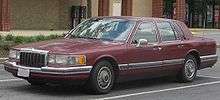
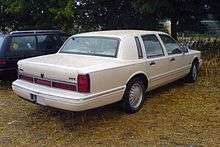
To lower the development and production costs of the extensive redesign, Ford Motor Company retained the Panther platform for the Lincoln Town Car, continuing its use of rear-wheel drive. In a major change, rear air suspension (introduced as an option for all three Panther vehicles in 1988) became standard equipment on all Town Cars. For 1990, the Town Car was produced with 11-inch rear drum brakes (identical to its 1989 predecessor); for 1991, they were replaced by 10-inch solid rear disc brakes.
Due to development delays in the Modular engine program, the 1990 Lincoln Town Car was released with the same powertrain as its predecessor: a 150 hp 5.0L (4.9L) V8 with a 4-speed AOD overdrive automatic. In 1991, the 5.0L V8 was replaced by a 190 hp 4.6L SOHC Modular V8; for the 1994 model year, the optional 210 hp dual-exhaust version of the engine became standard. Shared with the Ford Crown Victoria and Mercury Grand Marquis, the SOHC version of the 4.6L Modular V8 would see use in a number of other Ford vehicles within the Ford light-truck line, remaining in production into 2014. For 1993, the AOD transmission was converted to electronic operation, becoming the AOD-E. In 1995, the Town Car received the higher-torque 4R70W from the Lincoln Mark VIII.
| Engine | Displacement | Years Produced | Horsepower rating | Torque output | Notes | Transmission |
|---|---|---|---|---|---|---|
| Ford 5.0 Windsor V8 | 4.9 liters (302 cu in) | 1990 | 150 hp (112 kW) | 270 lb·ft (370 N·m) at 2,000 rpm | Single exhaust configuration, sold with base trim level | 4-speed overdrive automatic
1990-1992: Ford AOD 1993-1994: Ford AOD-E 1995-1997: Ford 4R70W |
| 160 hp (120 kW) | 280 lb·ft (380 N·m) at 2,200 rpm | Dual exhaust configuration, sold with Signature Series and Cartier | ||||
| Ford Modular SOHC V8 | 4.6 liters (281 cu in) | 1991-1997 | 210 hp (157 kW) | 275 lb·ft (373 N·m) at 3,250 rpm | Dual exhaust configuration, sold with Executive Series, Signature Series, and Cartier | |
| 1997 | 190 hp (142 kW) | 265 lb·ft (359 N·m) at 3,250 rpm | Single exhaust configuration, sold with Executive Series and select signature series only in 1997 |
Body
Exterior
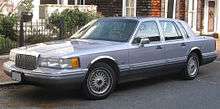

In its redesign for the 1990 model year, Lincoln sylists sought a completely new design for the Town Car. To bring the Town Car into the 1990s, many traditional Lincoln styling cues were heavily reworked or abandoned completely. Although the Town Car would keep its formal notchback sedan roofline, the flat-sided fenders and angular lines seen since the Continentals and Mark IIIs of the late 1960s disappeared. In their quest to give the Town Car a more aerodynamic body than its predecessor, stylists trimming its drag coefficient from 0.46 to 0.36 (matching the 1988 Continental and besting the Mark VII).[9] While far sleeker than its 1980s counterpart, the 1990 Town Car retained several styling influences, including its vertical taillights, radiator-style grille, hood ornament, alloy wheels, and vertical C-pillar window. In a move to market the Town Car towards buyers of contemporary vehicles, several other changes were made. Although two-tone paint remained available (featuring a lower body accent color in gray metallic), monotone paint schemes would become increasingly standard. In a major change, a vinyl roof was no longer standard equipment; although remaining a factory option for a couple years after the new Town Car debuted, vinyl roofs declined in popularity among many buyers. Spoked aluminum wheels were dropped from the option list for 1990, while locking wire wheel discs remained through 1992.
In 1993, the exterior was given a minor update with a new grille and slightly redesigned taillamp lenses (distinguished by a "checkerboard" pattern). As with the Crown Victoria and Grand Marquis, the Town Car received a larger update for 1995. This facelift is best distinguished by the deletion of the fixed quarter glass in the rear doors along with the redesign of the side mirrors (enlarged and changed to body-color). Although the bumper largely remained unchanged, the front fascia is updated as the headlamp clusters are changed to a clear-lens design and separated from the grille. The grille was redesigned, returning to the 1990-1992 design in a surround fitting closer to the body. The rear fascia saw the trim between the taillamps redesigned, featuring additional running lights, while the reverse lamps were moved from the outer edges of the reflector panel to the center, beneath the lid lock cover (similar to the 1985 - 1987 models).
Interior
In a departure from the Lincoln Continental and Mark VII, the use of the Panther platform necessitated a degree of component sharing with the Ford and Mercury counterparts. Although fitted with its own seats and door panels,[12] the Town Car was fitted with essentially the same dashboard as the Mercury Grand Marquis (versions with digital instruments retain the instrument panel layout from 1988-1989). In 1993, the wood trim was changed to an orange-toned walnut. Due to its popularity (and to better separate the Town Car from its Ford/Mercury counterparts), the digital instrument panel was made standard; as such, the climate-control system was converted to a digital display.
As part of its 1995 update, the interior saw a greater degree of change than the exterior. To bring the design up to date (and in line with the rest of the Lincoln line), the dashboard and door panels featured a curved design, while influenced by the Mark VIII, the 6-passenger design of the Town Car precluded the adoption of a center console in the interior. To increase storage space, the dual center armrests of the front seats on Signature and Cartier models were redesigned to include storage compartments (to hold cassettes and the optional cellular telephone). The dashboard design continued into the new door panels, now with an illuminated power window and seat adjuster cluster, and back-lit power door lock switch placed higher on the door. Releases for the trunk and fuel door were moved from the dashboard onto the lower driver's door. Redesigned seat patterns now offered an available driver and front passenger electric heat feature. The radio antenna was integrated into the rear window.[13] Although the basic controls of the interior remained common across all Panther vehicles, the Town Car gained a model-specific instrument panel, featuring italicized readouts.
For 1996, the climate controls were again redesigned; while Cartier Designer Editions featured genuine wood trim on the dashboard and door panels. In 1997, few changes were made: the rear center armrest added a pair of cup holders, while Cartier models gained rear-seat vanity mirrors mounted in the headliner.
Trim
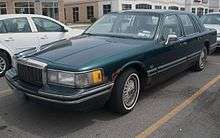
At its redesign in 1990, the Lincoln Town Car carried over its three previous trim levels: base, Signature Series, and Cartier Designer Edition. For 1991, the base trim was renamed Executive Series. From 1990 to 1996, the Lincoln Town Car was available with a factory towing package.
The Base (Executive Series from 1991 onward) Town Car offered six-passenger seating with two bench seats, a four-speaker AM/FM stereo with cassette player, 8-way front power seats, a four-speed overdrive automatic transmission, cloth seating surfaces, fifteen-inch tires, a digital LED dashboard, trip computer, dashboard clock, and keyless entry with Ford's SecuriCode keyless entry keypad.
The Signature Series added leather seating surfaces, standard alloy wheels, and an (optional) cloth imitation convertible roof. The Cartier Edition was fitted with the same features as the Signature Series, adding a JBL-branded sound system with amplifier, a security system, alloy spoked wheels, and other exclusive details, such as cloth and leather seats. In a departure from tradition, starting in 1990, Cartier Designer Edition Town Cars were no longer available in a single color combination yearly, but in several different interior/exterior combinations.[14] In addition, aside from gray lower body trim offered as an option for Signature Series Town Cars, Cartier Editions became the only two-tone versions of the Town Car.
In addition to the three standard trims of the Lincoln Town Car, various special edition option packages were produced by Lincoln (excluding dealer-produced versions).
Jack Nicklaus Signature Series (1992-1997)
The Jack Nicklaus Signature Series was a special-edition option package for the Town Car Signature Series that was featured a green exterior with a white top; the interior consisted of white leather with green accents. Another version of the package was sold with a white exterior and a standard roof; the interior trim was similar, with white leather seats and green carpets and trim.
Most Jack Nicklaus editions have ornaments and wording on the exterior trimmed in gold including green and gold "Golden Bear" badges on the front fenders.[15] Options included on the 1992 to 1997 Jack Nicklaus Signature Series included: Memory Seats with Power Lumbar/Recliner, Leather Seats and Monotone Paint.
Regatta Edition (1994)
The Regatta Edition was a maritime-themed special-edition option package for the Signature Series, with approximately 1,500 produced. The package consisted of White Oxford leather seats (with optional blue seat piping), with regatta blue carpeting; the doors and instrument panel featured matching blue-color trim.
The package was often paired with a white oxford vinyl carriage roof featuring embroidery on the "C" pillar near the opera windows.
Spinnaker Edition (1995)
Replacing the Regatta Edition, the Spinnaker Edition option package featured tri-coat paint, two-toned leather seats, the Spinnaker logo on the floor mats, and 16" spoked aluminum wheels.
Diamond Anniversary Edition (1996)
To commemorate the 75th anniversary of Lincoln in 1996, the division sold a Diamond Anniversary Edition of the Town Car Signature Series (alongside the Continental and Mark VIII). Featuring a unique accent stripe, leather seats, wood instrument panel trim, window badging, cellular telephone, power moonroof, JBL audio system, auto electrochromatic dimming mirror with compass, and traction assist,[16] the Diamond Anniversary Edition included nearly every available option on the Lincoln Town Car.
Cypress Edition (1996)
The Cypress Edition of the Signature Series featured Cypress Gold Frost exterior paint, a two-toned leather interior, and red Cypress tree badging.
Features
At its 1990 redesign, the Lincoln Town Car was offered with relatively few options, with nearly all features as standard equipment. On the Signature Series, the only options were leather seat trim, a moonroof, a 10-disc CD changer, JBL sound system, security system, and onboard telephone.
The redesign highlighted several new features that had never been available before on the Town Car. A two-position driver's memory seat was standard on Cartier Editions (optional on Signature Series); the memory seats featured 8-way adjustment for both seats and inflatable lumbar support. While technically a carryover feature from 1989, the Electrochromic Dimming Mirror was redesigned for the much wider rear window of the new Town Car.
A number of advances were made in the safety features available for the Lincoln Town Car, with ABS becoming an optional feature in 1990. Following the return of 4-wheel disc brakes to the Town Car in 1991 (for the first time since 1979), ABS became standard in 1992. As with the rest of the Panther-platform vehicles, the Town Car was fitted with a drivers' side airbag in 1990, although the Town Car was technically designed to be fitted with dual airbags (the first American-produced luxury vehicle to be fitted with them). However, due to supply problems with the passenger airbag module, the passenger airbag essentially became a delete option, with a credit on the window sticker issued for the price of the missing airbag. Upon owner request, for the price of the issued credit, the passenger airbag would be installed. By the beginning of the 1992 model year, all Town Cars come equipped with dual airbags from the factory.
Third generation (1998–2011)
| Third generation | |
|---|---|
 | |
| Overview | |
| Also called |
Lincoln Town Car L FAW Hongqi CA7460 FAW Hongqi Limousine |
| Production | October 1997–September 15, 2011 |
| Model years | 1998–2011 |
| Assembly |
Wixom, Michigan, U.S. (1998–2007) St. Thomas, Ontario, Canada (2008–2011) |
| Designer | Fritz Mayhew |
| Body and chassis | |
| Body style | 4-door sedan |
| Related |
Mercury Grand Marquis Mercury Marauder Ford Crown Victoria Hongqi CA7460/Hongqi Qijian(红旗旗舰) |
| Powertrain | |
| Engine | 4.6 L Modular SOHC V8 |
| Transmission |
4-speed 4R70W automatic 4-speed 4R75W automatic |
| Dimensions | |
| Wheelbase |
Town Car: 117.7 in (2,990 mm)[17] Town Car L: 123.7 in (3,142 mm) |
| Length |
1998–2002 Town Car: 215.3 in (5,469 mm) 2003–2011 Town Car: 215.4 in (5,471 mm) 2001–2004 Town Car L: 221.3 in (5,621 mm) 2005–2011 Town Car L: 221.4 in (5,624 mm) |
| Width |
1998–2002: 78.2 in (1,986 mm) 2003–2011: 78.5 in (1,994 mm) |
| Height |
1998–2002: 58.0 in (1,473 mm) 2003–08 Town Car: 58.6 in (1,488 mm) 2003–08 Town Car L: 58.7 in (1,491 mm) 2009–2011 Town Car: 59.0 in (1,499 mm) 2009–2011 Town Car L: 59.1 in (1,501 mm) |
| Curb weight |
Town Car: 4,006–4,369 pounds (1,817–1,982 kg)[18][19] Town Car L: 4,360–4,517 pounds (1,978–2,049 kg)[20][21] |
.jpg)
For the 1998 model year, Ford gave its full-size cars for all three divisions major redesigns, with the Town Car receiving the most attention. Adopting much more rounded lines than its predecessor, the Lincoln Town Car carried on the styling of the Lincoln Mark VIII and the 1995 Lincoln Continental. Although introduced nearly concurrently with the truck-based Lincoln Navigator full-size SUV, the redesign of the Town Car also marked a change in the role of Lincoln within Ford Motor Company.
During the creation of the third-generation Town Car, the structure of Lincoln was being shifted from the Lincoln-Mercury Division to within the Premier Automotive Group. While still a division of Ford, PAG was a grouping of Lincoln with higher-end automotive brands owned by the company (Land Rover, Aston Martin, Jaguar, Volvo). As the grouping of Lincoln within PAG was considered unsuccessful (with Lincoln falling behind Cadillac in sales after 2000), the Lincoln-Mercury division was restored to its previous structure by 2002.
At the end of the 2007 model year, Ford discontinued operations at the Wixom Assembly Plant, putting the future of the Town Car at risk. For the 2008 model year, production of the Town Car was transferred to the St. Thomas Assembly plant in Canada, alongside Ford Crown Victoria and Mercury Grand Marquis.
Chassis
For its redesign in the 1998 model year, the Lincoln Town Car retained the Ford Panther platform that had underpinned its predecessor. To improve the cornering stability of the Town Car, a Watt's linkage was fitted to the solid rear axle suspension (a change also seen in its Mercury and Ford counterparts). The front brake calipers were changed to a larger dual-piston design; 16-inch wheels became standard.
For 2003, the chassis of the Town Car was extensively redesigned in an effort to modernize its road manners. In addition to a completely redesigned frame, major changes were made to the tuning of the suspension. To further improve handling, the steering was changed from a recirculating-ball to a rack-and-pinion configuration.
Powertrain
In the redesign, the Lincoln Town Car carried over its Modular V8 (shared with the Crown Victoria/Grand Marquis). For the first time since its 1991 introduction, the 4.6L SOHC V8 saw in increase in output, rising to 200 hp in Executive/Signature models; dual exhaust Town Cars produced 220 hp in Cartier trim with 239 hp in Signature Touring versions. In 2000, the V8 was retuned to 200/215 hp, rising to 220/235 hp in 2001. For 2003, the powertrain would get a final power increase, rising to 224/239 hp.
From 1998 to 2002, the Town Car used the 4R70W 4-speed automatic introduced in 1995. From 2003 onward, the heavier-duty 4R75W replaced it.
| Engine | Displacement | Years produced | Horsepower rating | Torque output | Notes |
|---|---|---|---|---|---|
| Ford Modular SOHC V8 | 4.6 liters (281 cu in) | 1998-2000 | 205 hp (153 kW) | single-exhaust, sold with Executive Series, Signature Series | |
| 1998-2000 | 220 hp (164 kW) | 290 lb·ft (390 N·m) at 3,500 rpm | dual-exhaust, sold with Cartier | ||
| 2000-2002 | 235 hp (175 kW) | 285 lb·ft (386 N·m) | dual-exhaust, sold with Town Car L | ||
| 2001-2002 | 235 hp (175 kW) | 287 lb·ft (389 N·m) at 3,500 rpm | dual-exhaust, sold with Executive Series, Signature Series | ||
| 1998-2011 | 239 hp (178 kW) | 287 lb·ft (389 N·m) at 4,100 rpm | Introduced with 1998-2002 Signature Touring, this version became the sole engine for all Town Cars from 2003 to 2011. |
Body
Exterior
While three inches shorter than its 1997 predecessor, the 1998 Town Car gained two inches in width and an inch in height (becoming the tallest Lincoln sedan in 40 years). In a major break from Lincoln styling tradition, the Town Car abandoned many of the straight-edged lines of its predecessor. Adopting styling cues of the outgoing Mark VIII and the 1995 Continental, the Town Car adopted a curved design scheme in place of the previous straight-lined body. While the radiator grille was retained, its rectangular shape was changed to oval (its waterfall pattern was adopted by the Lincoln Navigator introduced alongside it); in a controversial change, the hood ornament was deleted.
The curved design scheme carried further to the rear of the Town Car, in the C-pillar (losing its opera windows) into the trunklid. To better differentiate itself from its Mercury counterpart, the Town Car switched to individual taillamps, deleting the filler panel on the trunklid; a large chrome surround was used on the trunklid to mount the license plate.
In 2001, the stretched Town Car L was introduced, with a six-inch stretch in its wheelbase. To produce the variant at the lowest cost possible, the B-pillar was widened on 2001-2002 versions to use the existing rear door glass of the standard Town Car. In 2003, the Town Car L was redesigned, giving it model-specific doors proportioned to the longer roofline; these versions are distinguished by wider rear quarter glass in the doors.
In 2003, coinciding with the chassis redesign, the body of the Town Car underwent a number of changes. To bring it in line with contemporary Lincoln vehicles, the lower body was squared off; the oval grille was redesigned in the style of the Lincoln LS; the hood ornament made its return after a 5-year absence.
Interior
As with its predecessors, the 1998 Lincoln Town Car visibly shares few common interior parts with its Ford and Mercury counterparts (aside from its steering column, radio, and climate controls). To improve ergonomics, power seat controls on Signature and Cartier models are relocated from the seat to door panel (Executive Series, in 1999). In a move to improve safety, seat-mounted side airbags become standard on all Town Cars for 1999. In the same year, the Executive Series regains its rear-seat center armrest (initially deleted in a cost-cutting move).
For its 2003 redesign, the interior of the Lincoln Town Car saw extensive changes. In a move to further differentiate the Town Car from the Mercury Grand Marquis, the radio and climate controls were integrated into a single unit with an analog clock; the interior was given a model-specific wood trim bordered by satin metal. The redesign included new seats, distinguished by taller head restraints. Alongside the Lincoln LS, the 2003 Town Car introduced a DVD-based satellite navigation system designed by Pioneer; it was later paired with THX sound processing. On all Town Cars except for Executive Series, ultrasonic park assist was standard, alongside a power-open/close trunk lid (this was known as "Trunk at a Touch").
For 2004, the "Soundmark" standard stereo system is redesigned to offer dual-media capability (AM/FM/cassette/CD). For 2005, for the first time since 1996, the Town Car receives a redesigned steering wheel. For 2006, the instrument panel was redesigned, with Lincoln Town Car gaining a tachometer alongside its Ford and Mercury counterparts; Lincoln Town Car is one of the last American-market vehicles sold without one.
As part of the shift in assembly plants, in 2008, to streamline production, Lincoln offers the Town Car with only 4 options: HID headlamps, whitewall tires, polished 18-spoke wheels (10-spoke machine-finished wheels are standard), and a trunk organizer; all previously optional features are either deleted or standardized.
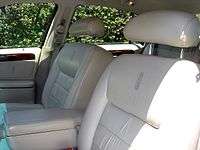
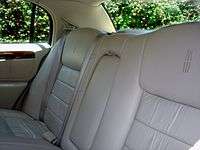
Trim
At its redesign for 1998, the Lincoln Town Car was produced in three trim levels: Executive Series (primarily for fleets and livery sales), Signature Series, and Cartier Designer Edition. A sub-model of the Signature Series from 1998 to 2002 was the Signature Series Touring, essentially the Lincoln counterpart to the Handling and Performance Package option for the Ford Crown Victoria/Mercury Grand Marquis.
In 2002, the Town Car line was expanded as Lincoln introduced Premium variants of the Signature Series, Cartier, and Signature Touring; the variants are best distinguished by their glass sunroofs.[22]
In 2004, Lincoln would make major changes to the model line. Executive Series Town Cars became sold exclusively to fleets/livery customers, while the Cartier was discontinued (after 27 years with the Town Car and the Continental Mark IV, V, and VI). To replace the Cartier, the Town Car Ultimate was introduced for 2004, featuring the THX sound system as standard. Lasting only one year, the Ultimate trim level was replaced in 2005 by Signature Limited (an option package introduced in 2000), with Signature Designer Series slotted below it. The Designer Series featured a two-tone interior with Provence leather; the rear seats included model-specific adjustable head restraints. Exterior trim of Designer Series Town Cars featured chromed B-pillars and chrome wheels. In 2008, the Designer Series was discontinued, as part of the shift from Wixom Assembly to St. Thomas Assembly.
In 2009, the model line is trimmed to the Signature Limited and the long-wheelbase Signature L; for 2010, a limited-edition Continental Edition variant of the Signature Limited was produced.
In a shortened 2011 model year, the Lincoln Town Car was produced in the same model line since 2009; the Signature Limited and Signature L were produced for retail sale while Executive/Executive L were produced for fleet/livery sale.
Special Editions
Touring
Intended to enhance the driving appeal of the Lincoln Town Car, the Touring/Touring Sedan was an option package for Signature Series Town Cars from 1998 to 2002. Essentially the Lincoln counterpart of the Ford Crown Victoria/Mercury Grand Marquis Handling and Performance Package, the Touring option package featured a dual-exhaust 239 hp V8h heavy-duty KONI shocks, revised suspension bushings, wider 16-inch wheels with 235mm tires, a 3.55 rear-axle ratio, and revised steering tuning. Town Cars with the option package are distinguished by a black-painted grille, exterior chrome delete, black wood interior (fitted with perforated leather seats and a JBL Audiophile quality sound system).
Pro Series
In 2005, a Pro Series edition/option package was available on the Signature Limited and included embroidered "Pro Series" logos on driver/front passenger seat backs, 9-spoke chrome wheels, chrome B-pillar, two-tone instrument panel, and floor mats with "Pro Series" brushed aluminum badges.
25th Anniversary Edition
Lincoln commemorated the 25th anniversary of the Town Car by offering a 25th Anniversary Edition package on the 2006 Signature Limited. The package included chrome B-pillar and door handles, unique Eucalyptus wood applique and matching steering wheel with wood inserts, scuff plates with "25th Anniversary Edition" and "25th anniversary" badging, Provence leather individual 40/20/40 lounge seating with individual comfort, shirring, contrast piping and rear seat adjustable headrests, foglamps and 9-spoke chrome wheels.
Continental Edition
Offered in 2010 and 2011 was the Continental Edition package; available as an option only on the Signature Limited trim. The package added Continental badging, chrome 17-inch wheels and accents to the B-pillars. On the interior, the Continental name was embroidered on the front seats and front floor mats.
Trim levels

In 1981 the Town Car was introduced in three trim levels: the base model, the mid-range Signature Series, and the top-of-the-line Cartier Series. In 1991, the Executive Series became the designation for the base/entry model. In 2004, the Cartier name was dropped and replaced by Ultimate, and the Executive Series name was now only used for fleet vehicles going forward. This left the Signature Series as the entry level model. In 2005, however, the lineup was changed again and all three trim levels carried a Signature badge: Signature, Signature Limited, and Signature L. In 2006 and 2007, a Designer Series was added to fit in between the mid-range Signature Limited and the top-of-the-line Signature L. Starting in 2008 and through the end of the model run, the Signature Limited and Signature L were the only retail trim levels available.
Signature (1981–2011)
The Signature Series was the mid-level, and also most popular, trim level from 1981 through 2003. In 2004 the trim levels were renamed, and the Signature Series was now used to describe the base trim level and Ultimate was now used to describe the upper level trim. In 2005 the Ultimate was dropped and all trim levels were changed to a version of Signature. The base trim level for 2005 was called Signature, the mid trim level was called Signature Limited and the top-of-line trim-level was called Signature L. The trim level designations were revised again for the 2006 model year with a Designer Series being added between the Signature Limited and top-of-line Signature L. By 2008, with only two models remaining, the Signature Limited became the base model, while the Signature L badge was used for the extended-wheelbase model.
Cartier (1981–2003)
Cartier was used on the top-of-line Town Car from 1981 through 2003, including LWB or "L" versions 2000–2003. The Cartier also featured the designer's logo stitched onto the seats in place of the Lincoln star. Golden Lincoln emblems on the tail-lights also became a staplemark on the Cartier Edition on 1998 through 2002 models.
Executive (1991–2003 for retail and 2004–2011 for fleet)
The Executive Series was the base trim level and thus the most affordable Lincoln Town Car from 1991 through 2003. After 2003, the Executive Series designation continued on, but for fleet vehicles only and included both SWB and LWB versions.
Limited (2000–2004) and Signature Limited (2005–2011)
"Limited", as an option package, was available on Signature trim models from 2000 to 2003 and on the Ultimate in 2004. Starting in 2005, Limited (known as Signature Limited) became its own trim level.
Ultimate (2004)
Ultimate was only used on the 2004 Town Car. The Ultimate designation replaced Cartier for 2004 and was used for the top-of-line model. Like the Cartier, it was offered in SWB and LWB versions.
Designer (2006–2007)
The Designer Series was an upper-middle trim level in between the Signature Limited and Signature L. This trim included two-tone interior accents, a special higher quality leather called Provence leather. The rear seats also included four way adjustable head restraints exclusively on this trim for the standard wheelbase. On the exterior special chromed B pillars and chrome wheels were included.
Aftermarket
Throughout the entire run of the Town Car, numerous aftermarket companies and Lincoln-Mercury dealerships offered unique "trim packages" that typically included special roof treatments, grilles, wheels and badging. These were especially popular in the 1980s and 1990s.
Trim level timeline
| Lincoln Town Car Timeline | |||||||||||||||||||||||||||||||||||||||||||||||||||||||||||||||||||||||||||||||||||
| Trim level | 1980s | 1990s | 2000s | ||||||||||||||||||||||||||||||||||||||||||||||||||||||||||||||||||||||||||||||||
| '81 | '82 | '83 | '84 | '85 | '86 | '87 | '88 | '89 | '90 | '91 | '92 | '93 | '94 | '95 | '96 | '97 | '98 | '99 | '00 | '01 | '02 | '03 | '04 | '05 | '06 | '07 | '08 | '09 | '10 | '11 | |||||||||||||||||||||||||||||||||||||||||||||||||||||
| Entry | Base | Executive Series | Signature Series | Signature Limited | |||||||||||||||||||||||||||||||||||||||||||||||||||||||||||||||||||||||||||||||
| Mid-level | Signature Series | Signature Limited | |||||||||||||||||||||||||||||||||||||||||||||||||||||||||||||||||||||||||||||||||
| High-end | Cartier Series | Ultimate | Designer Series | ||||||||||||||||||||||||||||||||||||||||||||||||||||||||||||||||||||||||||||||||
| L | Cartier L | Ultimate L | Signature L | ||||||||||||||||||||||||||||||||||||||||||||||||||||||||||||||||||||||||||||||||
| Fleet | Executive, Executive L | ||||||||||||||||||||||||||||||||||||||||||||||||||||||||||||||||||||||||||||||||||
Variants
Livery variants
.jpg)
Featuring a standard V8 engine, body-on-frame design, rear-wheel drive and large exterior and interior dimensions,[23] the Town Car became popular in livery and commercial service. In commercial service, the typical Lincoln Town Car saw a life expectancy of over 400,000 miles.[24] Its basis on the Ford Panther chassis gave it powertrain and suspension commonality with the Mercury Grand Marquis and the Ford LTD Crown Victoria (later the Crown Victoria). This design made them durable even in the rough conditions taxi and livery cars are subjected to, and easy and cheap to repair when they did suffer damage.[24]
The Lincoln Town Car was popular as a stretch limousine donor chassis; it was the most commonly used limousine and chauffeured car in the United States and Canada.[25]
Presidential State Car

A 1989 Lincoln Town Car was commissioned by United States President George H. W. Bush as the Presidential State Car of the United States to succeed the 1983 Cadillac Fleetwood used during the Ronald Reagan administration. The Presidential Town Car limousine arrived in 1989 and was the state car for the entire presidency of George H. W. Bush. It was succeeded by a Cadillac Fleetwood, delivered in 1993, which was used by his successor, Bill Clinton.
As of 2016, the 1989 Lincoln Town Car is the last Lincoln vehicle to have served as a Presidential State Car.
Town Car L
A new "L" designation was used for extended-wheelbase Town Cars from 2000 to 2011. The L editions offered an additional 6 in (150 mm) of rear-seat legroom, as well as remote access audio and climate controls mounted in the rear center armrest. Also included was a two-way travel switch for the front passenger seat base (a feature shared with the extended-wheelbase Jaguar XJ). This L egnation was similar to that used on other luxury flagship sedans such as the BMW 7-Series or the Mercedes-Benz S-Class. The L designation was applied to the top-of-line Cartier (2000–2003), Ultimate (2004 only), and Signature (2005–2011) trim levels. Fleet buyers received it under the Executive L trim designation.
For 2000–02 versions, the "L" edition is best identified by a widened B-pillar, bearing the Lincoln "star" ornament; this was done to maintain parts commonality with the standard Town Car. 2003-2011 "L" editions are distinguished by longer rear doors, featuring wider versions of the fixed windows seen in the Town Car doors.
Ballistic Protection Series
Starting in 2003, the Lincoln Town Car had been available featuring ballistic protection from the factory. Adding nearly $100,000 to the base price, the armored body and bulletproof glass raised the curb weight of the Town Car to nearly 7,000 pounds.[26] Other changes to the suspension and brakes were intended to preserve the handling of the Town Car. Only a handful of Lincoln dealers in the US were authorized to sell this series.
Hongqi CA7460
See main page, Hongqi (marque)
In China, FAW produced a licensed version of the Lincoln Town Car rebadged as the Hongqi CA7460(红旗,Red flag CA7460) and Hongqi Qijian(红旗旗舰,Flagship) from November 10, 1998[27] to 2005.[28] However the limousine version continues to be produced and sold in China. The limousine version is currently called the Hongqi Limousine.
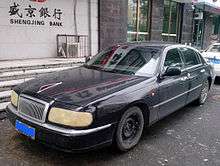
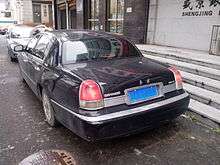
Sales
| Calendar Year | American sales |
|---|---|
| 1994[11] | 120,191 |
| 1995[11] | 92,673 |
| 1996[11] | 93,598 |
| 1997[11] | 92,297 |
| 1998[11] | 97,547 |
| 1999[11][29] | 84,629 |
| 2000[11] | 81,399 |
| 2001[11][30] | 66,859 |
| 2002[31] | 59,312 |
| 2003[11] | 56,566 |
| 2004[11][32] | 51,908 |
| 2005[11] | 47,122 |
| 2006[33] | 39,295 |
| 2007 | 26,739 |
| 2008[34] | 15,653 |
| 2009[35] | 11,375 |
| 2010[36] | 11,264 |
| 2011[37] | 9,460 |
| 2012[38] | 1,001 |
| Total | 1,058,888 |
Discontinuation
In spite of declining sales, the Town Car remained one of the best selling American luxury cars; it was the United States' and Canada's most used limousine and chauffeured car.[25]
In 2006, as part of The Way Forward, Ford considered ending production of Lincoln's largest model as part of the 2007 closing of the Wixom Assembly Plant.[39] Industry observer George Peterson said "It blows everybody’s mind that they are dropping the Town Car. Just think what Ford could do if they actually invested in a re-skin of Crown Victoria, Grand Marquis and Town Car."[40] Ford ultimately decided to keep the model and move assembly to the St. Thomas Assembly Plant in Ontario, Canada; this was home to the Ford Crown Victoria and Mercury Grand Marquis; both models also used the Ford Panther platform. The Town Car's manufacture resumed at its new location in late 2007.[25] The first Canadian-assembled Town Car was built on January 10, 2008.[41] However, in Canada, Town Cars were sold exclusively for fleet and livery sales, having been discontinued in retail markets after the 2007 model year.
In 2009, the fate of all three Panther-platform models was determined when Ford announced the 2011 closure of the St. Thomas Assembly Plant. For the limousine and livery markets, Ford had promised availability of the Town Car through the 2011 model year;[42] retail sales continued on a limited basis in the United States and for export. On January 4, 2011, the Town Car became the last Panther-platform variant available for retail sale as the final Mercury Grand Marquis was produced (the last Mercury-brand vehicle). On August 29, 2011, the final Town Car rolled off the assembly line, without any fanfare or announcement from Ford.[43]
After the Town Car's discontinuation following the 2011 model year, the Town Car was left without a direct replacement. Although dimensionally a full-size sedan, the Lincoln MKS's architecture is considerably different as it has a front-wheel drive unibody platform with optional all-wheel drive. The MKS is marketed more as of a successor to the sportier Lincoln LS as well as the 1995–2002 Continental. To fill the gap left by the Town Car, Lincoln has remained in livery markets by developing a limousine variant of the MKT full-size crossover vehicle, which was made available around the second quarter of 2012 and is known as the "MKT Town Car."[44][45]
Awards
The Town Car has received several awards and recognitions.
- Forbes magazine repeatedly named the Town Car one of the best cars to be chauffeured in along with other, often more expensive flagship sedans, such as the Mercedes-Benz S-Class, BMW 7-Series and Lexus LS.[46] The Town Car Signature L features a rear seat comfort package which not only provides rear seat passengers with audio system and rear compartment climate controls, but also features a control function which allows for the rear seat occupants to move the passenger seat forward, a feature exclusive to few ultra-luxury sedans.[46] In addition to its many amenities, the Signature L also features an unrivaled 46.9 in (1,191 mm) of rear legroom, and 60 in (1,524 mm) of rear shoulder room.[1]
- In 1990, upon the introduction of the second generation Town Car, the vehicle was named Motor Trend Car of the Year.[47] However this award was later included by Car and Driver in a list of poorly chosen car of the year award winners.[48] It should be noted that Motor Trend has changed the criteria by which it awards its highest accolade: Originally, Car of the Year awards went to the vehicle model which was the most significantly improved over the previous year's design in all respects. Currently, no such consideration is given to contenders for this award, and vehicles are considered for the award even if in their first year of production.
Safety
The Lincoln Town Car was the first production sedan in the world to receive US five-star crash ratings in every category. National Highway Traffic Safety Administration (NHTSA) 2010 Lincoln Town Car Crash Test Ratings (with side airbags)[49]
- Frontal Driver:

- Frontal Passenger:

- Side Impact (Driver):

- Side Impact (Passenger):

- Rollover:

National Highway Traffic Safety Administration (NHTSA) 2000 Lincoln Town Car Crash Test Ratings (with side air bags)[50]
- Frontal Driver:

- Frontal Passenger:

- Side Impact (Driver):

- Side Impact (Passenger):

- Rollover: N/A
National Highway Traffic Safety Administration (NHTSA) 1990 Lincoln Town Car Crash Test Ratings[51]
- Frontal Driver:

See also
- Ford Crown Victoria/Police Interceptor
- Mercury Grand Marquis/Marauder
- Ford Panther platform
- Lincoln Mark Series
References
- 1 2 "Official Lincoln Town Car technical specifications". Retrieved June 22, 2006.
- ↑ "The Roaring 20s". Lincoln. Retrieved July 15, 2010.
- ↑ "Lincoln Town car portfolio 1987". Lincoln-Mercury division of the Ford Motor Company. Retrieved November 21, 2011.
- ↑ "1981 LINCOLN TOWN CAR 2-Door data in automobile-catalog.com".
- ↑ "1982 Lincoln Town Car 1st-gen. 4-Door". Automobile-catalog.com. Retrieved 11 February 2014.
- ↑ "1986 Lincoln Town Car 1gen 4-Door specifications, performance data". Automobile-catalog.com. Retrieved 2013-01-13.
- 1 2 3 4 5 "The Complete "Box" Panther History". Retrieved 22 March 2014.
- ↑ "Youtube, 1993 Lincoln Commercial". Retrieved August 17, 2007.
- 1 2 "1990 Lincoln Town Car 2gen 4-Door Sedan specifications, performance data". Automobile-catalog.com. Retrieved 2013-01-13.
- ↑ "1996 Lincoln Town Car 2gen 4-Door Sedan specifications, performance data". Automobile-catalog.com. Retrieved 2013-01-13.
- 1 2 3 4 5 6 7 8 9 10 11 12 "Forbes on the Town Car, sales figures since 1994". Archived from the original on December 12, 2007. Retrieved October 3, 2006.
- ↑ "Design changes for the second generation Town Car". Retrieved August 2, 2006.
- ↑
- ↑ "1990 Lincoln Town Car Brochure". Retrieved November 18, 2006.
- ↑ "1Town Car Special Editions". Retrieved November 18, 2006.
- ↑ "Town Car Options list with Prices". Retrieved November 18, 2006.
- ↑ "2011 Town Car Specifications | View Interior, Exterior, Capacities, & Engine Specs". Lincoln.com. Retrieved December 31, 2011.
- ↑ "1998 Lincoln Town Car 3gen 4-Door Sedan specifications, performance data". Automobile-catalog.com. Retrieved 2013-01-13.
- ↑ 2004 LINCOLN TOWN CAR ULTIMATE data in automobile-catalog.com
- ↑ "2001 Lincoln Town Car 3gen L-Series specifications, performance data". Automobile-catalog.com. Retrieved 2013-01-13.
- ↑ "2011 Lincoln Town Car 3gen L-Series specifications, performance data". Automobile-catalog.com. Retrieved 2013-01-13.
- ↑ "AOL Autos-Used cars-2002 Lincoln Town Car-Available Trims". Retrieved 13 April 2014.
- ↑ "Forbes, Lincoln Town Car review, 2006". Retrieved August 2, 2006.
- 1 2 http://telegraphjournal.canadaeast.com/opinion/article/1443706 Archived April 21, 2012, at the Wayback Machine.
- 1 2 3 "Lincoln Town Car wins stay of execution". Spero News. September 19, 2006. Retrieved July 15, 2010.
- ↑ "Armored Town Car pricing". Retrieved March 25, 2007.
- ↑ "Tycho's Illustrated History Of Chinese Cars: Red Flag's Lincoln Years". thetruthaboutcars.com. Retrieved 2013-01-29.
- ↑ "请别再颓废下去!红旗品牌发展史(下)_唐海吧_百度贴吧". baidu.com. Retrieved 2013-01-29.
- ↑ "Ford Motor Company Sets New Full Year U.S. Sales Record". Theautochannel.com. Retrieved April 28, 2009.
- ↑ "Ford Motor Company's December U.S. Sales Climb 8.2 Percent" (PDF). Ford Motor Company.
- ↑ "Ford's F-Series Truck Caps 22nd Year in a Row as America's Best-Selling Vehicle With a December Sales Record". Theautochannel.com. November 17, 2004. Retrieved April 28, 2009.
- ↑ "Ford Achieves First Car Sales Increase Since 1999". Theautochannel.com. November 17, 2004. Retrieved April 28, 2009.
- ↑ "Ford Motor Company 2007 sales". January 3, 2008.
- ↑ "F-Series drives ford to higher market share for third consecutive month" (PDF). Ford Motor Company. January 5, 2009. Retrieved May 14, 2009.
- ↑ "FORD CAPS 2009 WITH 33 PERCENT SALES INCREASE, FIRST FULL-YEAR MARKET SHARE GAIN SINCE 1995 | Ford Motor Company Newsroom". Media.ford.com. January 5, 2010. Retrieved September 30, 2010.
- ↑ "Ford's 2010 sales up 19 percent – largest increase of any full-line automaker; foundation set for growth in 2011" (PDF) (Press release). Ford Media. January 4, 2011. Archived from the original (PDF) on January 24, 2011. Retrieved November 10, 2014.
- ↑ "2011 Ford Brand Sales up 17 Percent for the Year in U.S.; Fuel-Efficient Cars, Utilities, Trucks Drive Sales Gains" (PDF) (Press release). Ford Media. January 4, 2012. Archived from the original (PDF) on January 31, 2012. Retrieved November 10, 2014.
- ↑ "Ford Cars, Utilities and Trucks All Post U.S. Sales Gains in 2012; Company Posts Best December Sales Since 2006" (PDF) (Press release). Ford Media. January 3, 2013. Archived from the original (PDF) on January 23, 2013. Retrieved November 10, 2014.
- ↑ "Search – Global Edition – The New York Times". International Herald Tribune. March 29, 2009. Retrieved October 31, 2009.
- ↑ Garrett, Jerry (July 16, 2006). "Town Cars Next Stop: Retirement". The New York Times. C1 control character in
|title=at position 9 (help) - ↑ "First Ontario-built Lincoln Town Car rolls off assembly line". CanadianDriver. Retrieved July 15, 2010.
- ↑ "Ford Fleet: Town Car Extension Through 2011" (PDF). Retrieved December 31, 2011.
- ↑ "Lincoln MotorCar News". Retrieved January 11, 2012.
- ↑ "Fleet Showroom" (PDF). fleet.ford.com. Archived from the original (PDF) on September 17, 2012. Retrieved 11 February 2014.
- 1 2 "Forbes, best chauffeured cars". Archived from the original on September 25, 2011.
- ↑ "Motor Trend car of the year list – 1990". Motor Trend. Retrieved July 15, 2010.
- ↑ "Dishonorable Mention: The 10 Most Embarrassing Award Winners in Automotive History- Yahoo! Autos Article Page". Autos.yahoo.com. October 27, 2009. Retrieved October 31, 2009.
- ↑ http://www.safercar.gov/Vehicle+Shoppers/5-Star+Safety+Ratings/1990-2010+Vehicles/Search-Results?searchtype=model&make=LINCOLN&model=TOWN+CAR&year=2010
- ↑ http://www.safercar.gov/Vehicle+Shoppers/5-Star+Safety+Ratings/1990-2010+Vehicles/Search-Results?searchtype=model&make=LINCOLN&model=TOWN+CAR&year=2000
- ↑ http://www.safercar.gov/Vehicle+Shoppers/5-Star+Safety+Ratings/1990-2010+Vehicles/Search-Results?searchtype=model&make=LINCOLN&model=TOWN+CAR&year=1990
External links
![]() Media related to Lincoln Town Car at Wikimedia Commons
Media related to Lincoln Town Car at Wikimedia Commons
| « previous Lincoln, a luxury division of Ford Motor Company – road car timeline, 1980–present | |||||||||||||||||||||||||||||||||||||||
|---|---|---|---|---|---|---|---|---|---|---|---|---|---|---|---|---|---|---|---|---|---|---|---|---|---|---|---|---|---|---|---|---|---|---|---|---|---|---|---|
| Body | Class | 1980s | 1990s | 2000s | 2010s | ||||||||||||||||||||||||||||||||||
| 0 | 1 | 2 | 3 | 4 | 5 | 6 | 7 | 8 | 9 | 0 | 1 | 2 | 3 | 4 | 5 | 6 | 7 | 8 | 9 | 0 | 1 | 2 | 3 | 4 | 5 | 6 | 7 | 8 | 9 | 0 | 1 | 2 | 3 | 4 | 5 | 6 | 7 | ||
| Sedan | Mid-size | Versailles | Continental | Continental | Continental | Zephyr/MKZ | MKZ | ||||||||||||||||||||||||||||||||
| LS | |||||||||||||||||||||||||||||||||||||||
| Full-size | MKS | Continental | |||||||||||||||||||||||||||||||||||||
| Continental | Town Car | Town Car | Town Car | ||||||||||||||||||||||||||||||||||||
| Mark Series | Personal luxury car | Continental Mark VI | Continental/Lincoln Mark VII | Lincoln Mark VIII | |||||||||||||||||||||||||||||||||||
| Truck | Mid-size SUV | Aviator | |||||||||||||||||||||||||||||||||||||
| Full-size SUV | Navigator | Navigator | Navigator | ||||||||||||||||||||||||||||||||||||
| Compact CUV | MKC | ||||||||||||||||||||||||||||||||||||||
| Mid-size CUV | MKX | MKX | |||||||||||||||||||||||||||||||||||||
| Full-size CUV | MKT | ||||||||||||||||||||||||||||||||||||||
| Pickup truck | Blackwood | Mark LT | Mark LT (Mexico) | ||||||||||||||||||||||||||||||||||||